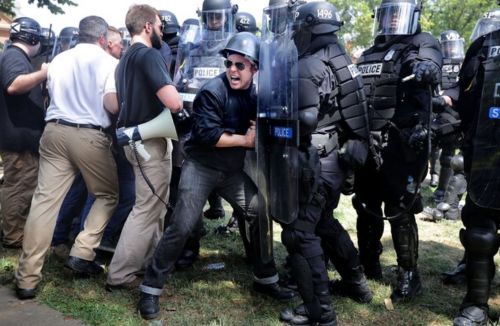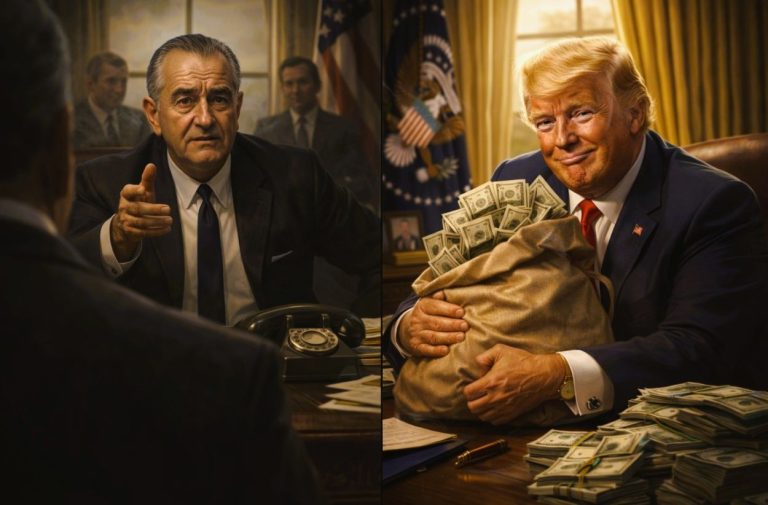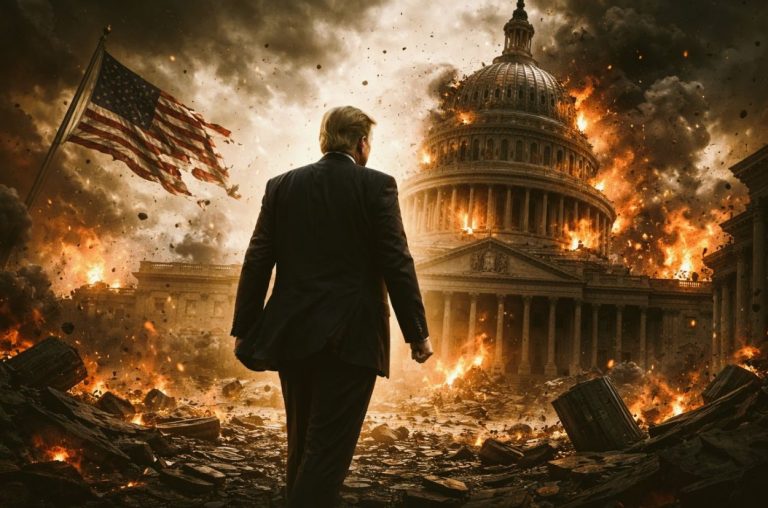

When political leaders wink at intimidation, when juries excuse perpetrators, when conspiracies are repeated by elected officials, the line between fringe extremism and mainstream politics dissolves.

By Matthew A. McIntosh
Public Historian
Brewminate
Introduction: The Politics of Violence
Political violence has always shadowed American democracy. From anarchist bombs to white supremacist terror, from militant labor strikes to armed militias, bloodshed has repeatedly been wielded as a tool to settle disputes that ballots and debates could not resolve. The question of which side of the spectrum has been more violent is not new, yet it is often clouded by myth, selective memory, and political weaponization. Both left and right have committed acts of violence over the past century. But what matters is not simply the body count; it is how those acts were tolerated, condemned, or folded into the political order.
The conversation is often distorted by memory. Images of radical students and underground bombers in the 1960s and 70s linger, even though their campaigns claimed relatively few lives. Meanwhile, the violence of white supremacist groups and militias, far more sustained and lethal, has often been pushed to the margins of national consciousness. What people remember shapes what they believe, and what they believe shapes how they act politically.
Looking at the record across the last hundred years, a clear trajectory emerges. Left-wing militancy flared dramatically in mid-century, often spectacular and frightening but fleeting. Right-wing violence, by contrast, has been more enduring, more lethal, and in recent decades far more dominant. From lynchings and church bombings to the Oklahoma City attack and the storming of the Capitol, the arc bends not toward symmetry but toward imbalance.
What follows traces that trajectory. It begins with anarchists and labor radicals in the early twentieth century, moves through the violent clashes of the Civil Rights and Cold War era, considers the reframing of extremes at the close of the century, and finally lands in the present, a moment when the overwhelming share of political violence comes from the far right. Along the way, it examines not only the incidents themselves but also the politics of perception: who is remembered as violent, who is forgotten, and who is excused.
Early 20th Century: Labor, Anarchists, and Reaction
The first decades of the twentieth century were marked by turbulence. Anarchist movements, rooted in anger at capitalism and the state, carried out bombings that shocked the public. In 1901, an anarchist assassinated President William McKinley, shaking the nation’s sense of stability. Two decades later, the 1920 Wall Street bombing killed thirty people and wounded hundreds, reminding Americans that discontent could reach the very center of American finance. These incidents were dramatic and captured headlines, feeding fears that radical left-wing politics were synonymous with chaos and terror.
At the same time, labor conflicts turned violent across the country. Strikes at places like Ludlow, Colorado, and Homestead, Pennsylvania, descended into bloodshed as miners and steelworkers fought with private guards and state militias. Workers were often armed, but so too were the police and hired security who enforced the interests of owners. The violence was rarely one-sided; yet the state almost always interpreted it as the fault of radical agitators, rather than as the predictable result of crushing working-class dissent under armed force.
While anarchists and labor militants made headlines with their bombs and strikes, an even larger system of violence operated with quieter regularity. The Ku Klux Klan, revived in 1915, grew into a mass organization with millions of members. It spread far beyond the South, infiltrating city governments, local law enforcement, and even national politics. Lynchings, often carried out in public spectacle, claimed hundreds of lives each year. They were not isolated crimes but deliberate acts of racial terror, designed to enforce white supremacy through fear.
The crucial difference lay not only in the scale of the violence but in how the state responded. Anarchists and suspected radicals faced deportations, mass arrests, and the infamous Palmer Raids, in which thousands were rounded up without warrants. Labor organizers were jailed or beaten down, their movements cast as threats to the republic. By contrast, lynch mobs and Klan rallies often unfolded with little interference from authorities. Local police sometimes participated directly, and juries frequently refused to convict perpetrators. Thus, in the early twentieth century, both left and right engaged in violence. But the social order magnified one while excusing the other. Left-wing radicals, though lethal at moments, were painted as existential threats and hunted accordingly. Right-wing violence, by contrast, was tolerated, normalized, and in some cases celebrated. That asymmetry shaped the century that followed.
Mid-20th Century: Cold War and Civil Rights
The mid-century decades brought a new wave of left-wing militancy. As the Cold War hardened political lines, radical groups emerged that saw violence as a means to disrupt what they considered an oppressive state. The Weather Underground, formed out of the student movement, carried out a series of bombings in the 1970s targeting government buildings.
Although these attacks were calculated to avoid casualties, they created an aura of danger that outlasted the group itself. Other organizations flirted with armed struggle, and the Black Panther Party’s highly visible displays of firearms made for striking imagery that unsettled mainstream America. Abroad, counterparts like the Red Army Faction in Germany and the Red Brigades in Italy demonstrated that leftist militancy was not an American anomaly but part of a broader Cold War landscape.
Yet while these groups occupied headlines and stoked fears of domestic terrorism, right-wing violence remained a more sustained, lethal force in the United States. The Civil Rights Movement encountered violence at every turn. The 16th Street Baptist Church bombing in Birmingham in 1963 killed four young girls preparing for Sunday worship. Medgar Evers, a tireless NAACP field secretary, was assassinated in his own driveway. Martin Luther King Jr. faced repeated threats before being killed in 1968. Lynching, though declining in sheer numbers, continued as a tool of racial intimidation. These were not random acts but coordinated efforts by white supremacists to preserve segregation and resist federal civil rights protections.
The state’s posture again revealed the imbalance. Left-wing groups, no matter how small or ineffective, became the targets of an all-encompassing federal campaign under COINTELPRO. The FBI infiltrated, disrupted, and often dismantled radical organizations, sometimes with methods that crossed legal boundaries. The Weather Underground was hounded into obscurity. The Panthers were not only surveilled but faced lethal confrontations with police. The message was clear: left-wing militancy, even when largely symbolic, would not be tolerated.
Right-wing violence, by contrast, was often treated with indulgence or neglect. Many perpetrators of church bombings, lynchings, and assassinations walked free after sympathetic juries refused to convict them. Local officials openly colluded with segregationists, and federal intervention came only when political pressure mounted. Violence from the right was not only tolerated but sometimes intertwined with the very institutions charged with preventing it.
Public memory, however, tended to exaggerate the dangers of the left. Images of radicals with clenched fists or bombs in satchels became emblematic of an era, while the persistent terror visited on Black communities faded into the background of national consciousness. The result was a distorted narrative: one side demonized as violent revolutionaries, the other normalized as part of the everyday struggle over “order.” The reality, measured in blood and lives lost, was far more lopsided.
Late 20th Century: Extremes Reframed
By the 1970s, the tide of left-wing militancy that had unsettled the previous decade was beginning to ebb. The Weather Underground dissolved into obscurity, its members scattered or imprisoned. The Black Panther Party, besieged by state repression and internal fractures, collapsed under the weight of both. While some radical environmental and animal rights groups emerged in the 1980s and 90s, their actions were largely focused on property destruction. Fires were set at construction sites or research labs, but lethal violence became increasingly rare. The specter of the revolutionary left still haunted the imagination, yet in practice its capacity for violence had dwindled to a shadow of its former self.
On the other side of the spectrum, the far right was adapting and regrouping. White supremacist groups rebranded into looser networks, adopting decentralized structures that allowed them to persist even as older hierarchies fractured. Neo-Nazis found common cause with anti-government extremists, while the militia movement gained traction in the 1990s. Anti-abortion extremists also surged: clinics were bombed, doctors were murdered, and intimidation campaigns spread. This was violence explicitly tied to a political agenda and often carried out in the name of religious or nationalist identity.
It was in this climate that one of the deadliest acts of domestic terrorism in American history unfolded. On April 19, 1995, Timothy McVeigh detonated a truck bomb outside the Alfred P. Murrah Federal Building in Oklahoma City, killing 168 people, including children in a daycare center. McVeigh’s attack on the federal government itself embodied the far-right’s increasing capacity for mass casualty violence.
Even beyond Oklahoma City, right-wing violence manifested in recurring waves. Anti-abortion extremists assassinated doctors, bombed clinics, and carried out hate crimes and murders driven by white supremacist ideology. Hate groups gained visibility; their networks, once marginal, leveraged rhetoric, racial resentment, and conspiratorial thinking to recruit and radicalize. By the close of the century, the left’s violence appeared more symbolic, disruptive, or localized, while the right’s violence had become deadly, persistent, and frequent.
This period reframed the American understanding of extremism. The left had once been associated with fiery radicals and guerrilla tactics, but by the 1990s its violence was largely symbolic, disruptive rather than deadly. The right, however, had shifted into a position of sustained lethality. It no longer needed large, hierarchical groups to spread fear. Lone actors, small cells, and diffuse networks proved more than capable of carrying out attacks that shook the nation. The shape of violence in the decades to come had already been set.
21st Century: The Right Ascendant
The new millennium began under the shadow of September 11. Islamist terrorism dominated headlines and political discourse, casting a long shadow over domestic extremism. The wars in Afghanistan and Iraq consumed attention and resources, while fears of al-Qaeda and later ISIS shaped the national security state. Yet beneath that global conflict, a different pattern of violence was unfolding at home.
Far-right extremism did not vanish in the wake of 9/11. Instead, it adapted and grew in the shadows of a political climate consumed by foreign enemies. White supremacists, anti-government militias, and conspiracy-driven movements used the internet to connect and radicalize. What had once required physical meetings or underground newsletters now spread with ease through forums, chatrooms, and eventually social media. The stage was set for a new era in which domestic terrorism would be carried out less by organized groups and more by lone actors radicalized online.
The early warning signs were easy to miss, or sometimes deliberately ignored. In 2012, a white supremacist gunman attacked a Sikh temple in Oak Creek, Wisconsin, killing six worshippers. Three years later, another extremist murdered nine Black parishioners during Bible study at Emanuel AME Church in Charleston. Synagogues, mosques, and Latino communities became recurring targets, each attack framed as part of a broader ideological war. In Pittsburgh in 2018, a gunman stormed the Tree of Life synagogue, killing eleven people in the deadliest attack on Jews in American history. The following year in El Paso, another extremist slaughtered twenty-three people at a Walmart after posting an anti-immigrant manifesto online.
The culmination of this trajectory came on January 6, 2021. Thousands of rioters, many affiliated with militia groups, white nationalist organizations, and conspiracy movements, stormed the U.S. Capitol in an attempt to halt the certification of a presidential election. Unlike previous episodes of political violence, this was not hidden in basements or fringe gatherings. It was broadcast live, carried out in the heart of government, and encouraged by the rhetoric of national leaders. For hours, the seat of American democracy was under siege, and the line between fringe violence and mainstream politics collapsed.
Left-wing violence during the same period, while present, remained relatively marginal. “Antifa” became a political bogeyman invoked to stir fear, yet the actual incidents attributed to antifascist activists generally involved street clashes, vandalism, or confrontations with far-right demonstrators. While destructive and sometimes dangerous, they did not produce the waves of mass casualties seen in right-wing attacks. Even during the nationwide protests following the murder of George Floyd in 2020, the overwhelming majority of violence came from clashes with police or opportunistic destruction, not organized left-wing militancy.
By the 2020s, the imbalance had become impossible to ignore. Study after study confirmed that far-right extremists were responsible for the overwhelming majority of ideological killings on American soil. Yet partisan narratives persisted in insisting on symmetry, portraying left-wing activists as an equal threat. This distortion of reality served a political purpose: by inflating the menace of the left, it obscured the far more lethal threat of the right.
Data and Trends
The numbers leave little room for doubt. Since the mid-1990s, the Center for Strategic and International Studies has tracked extremist plots and attacks in the United States. Their findings show that the vast majority have come from the far right, a pattern that has only grown stronger in the years after 2015. Notably, CSIS found right-wing attacks and plots accounted for the majority of all terrorist incidents in the United States between 1994 and 2020. In many years, right-wing actors perpetrated more than 90% of the attacks or foiled plots in that span.
The Anti-Defamation League’s assessments of extremist murders likewise reinforce this conclusion. In its 2024 report, the ADL found that all extremist-related killings in the U.S. that year were connected to what it classifies as far-right extremism, with white supremacists and anti-government extremists responsible for the deaths.
Academic and government researchers have documented dozens of studies showing that ideological homicides, when parsed by motive (race, religion, anti-government, etc.), disproportionately originate from far-right actors. A recent NIJ-archived report concluded that since 1990, far-right extremists committed 227 ideologically motivated homicide events that caused over 520 deaths, far exceeding far-left extremist attacks in the same period. Following the murder of Charlie Kirk, Trump’s DOJ removed that report from the database and it is no longer publicly accessible.
Public memory, however, often lags behind the data. The radical left of previous decades (Weather Underground, Panthers, militant student movements) still looms large in cultural memory. Yet the daily reality over the last three decades (indeed, especially since 2015) is that far-right violence is far more frequent, more deadly, and more normalized. Attacks on synagogues, mosques, houses of worship, immigrant communities, and government institutions far outnumber analogous attacks from left-wing extremists. The discrepancy is not subtle.
Conclusion: Violence, Memory, and Democracy
The record across the last century is uneven, but the trajectory is clear. In the early decades, anarchists and labor radicals grabbed headlines with bombs and strikes, but the deeper current of right-wing racial terror claimed far more lives. Mid-century, militant groups on the left erupted into public consciousness, only to fade under relentless state repression, while white supremacists and segregationists killed with relative impunity. By the late twentieth century, the left’s violence had narrowed into symbolic acts of disruption, while the right unleashed bombings, assassinations, and anti-abortion murders. And in the twenty-first century, the imbalance has hardened into a grim reality: far-right extremists now account for the overwhelming majority of politically motivated deaths in the United States.
What makes the present especially perilous is not simply the scale of violence but its normalization. When political leaders wink at intimidation, when juries excuse perpetrators, when conspiracies are repeated by elected officials, the line between fringe extremism and mainstream politics dissolves. The January 6 attack on the Capitol was not just a riot; it was the moment when violent rhetoric crystallized into violent action at the very core of government. That breach was not an aberration; it was the culmination of a longer history in which right-wing violence moved steadily inward from the margins.
Memory, too, plays a role in sustaining the danger. Many still picture the radicals of the 1960s when they hear the phrase “domestic terrorism,” despite the data showing that those groups are long gone and their modern successors are marginal. The images of clenched fists and underground bombings endure, while the reality of church shootings, synagogue massacres, and immigrant-targeted killings fades more quickly from collective consciousness. This distortion is not accidental; it serves political ends, allowing some to deflect attention away from the violence most threatening to democracy today. The lesson of the past century is that political violence is never merely about the act itself. It is about how society chooses to respond, whom it condemns, and whom it excuses. To deny the current imbalance is to risk repeating the same mistakes: minimizing the threat until it has already reshaped the political order. Violence, tolerated and normalized, corrodes democracy from within. What the evidence shows (stubbornly, repeatedly) is that the threat in the United States today comes overwhelmingly from the right. Confronting that reality is not partisan hysteria. It is the only way to preserve a democracy that violence, if unchecked, will consume.
Originally published by Brewminate, 09.23.2025, under the terms of a Creative Commons Attribution-NonCommercial-NoDerivatives 4.0 International license.


